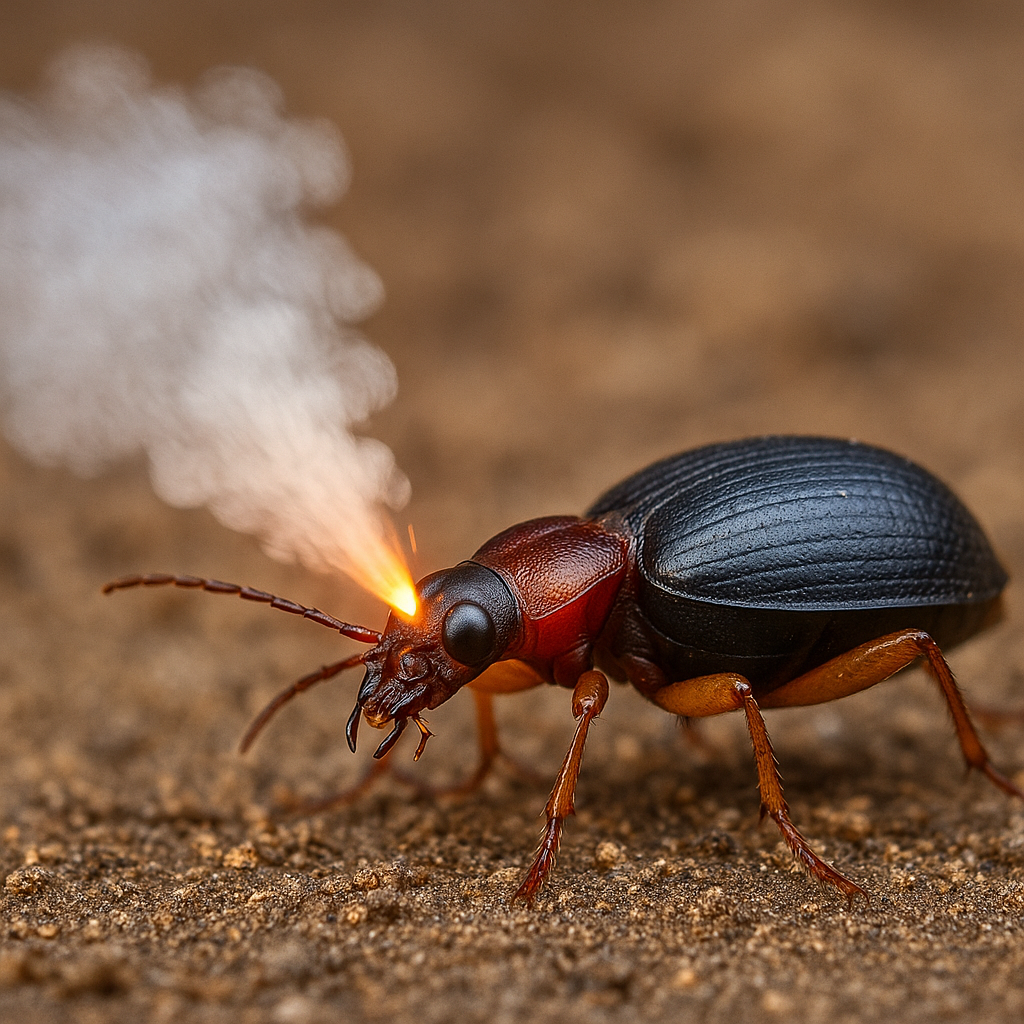⏲️ Estimated reading time: 5 min
🚀 Bombardier Beetle: Nature’s Explosive Chemist on Six Legs
The bombardier beetle defends itself like a tiny mobile laboratory. When threatened, it unleashes a boiling chemical spray with explosive force an astonishing natural defense mechanism that continues to fascinate scientists.
🔬 The Bombardier Beetle – A Tiny Master of Chemistry
When you think of deadly defense mechanisms in the animal kingdom, your mind might jump to venomous snakes, porcupines with sharp quills, or chameleons camouflaging themselves. But nature has given one small insect a unique and explosive trick the bombardier beetle. This tiny insect doesn’t bite, sting, or run. Instead, it explodes.
No bigger than a fingernail, the bombardier beetle turns into a miniature chemical lab when threatened, firing a high-temperature jet of liquid at its enemies. This weapon isn’t just effective it’s chemically brilliant.
💥 How It Works: An Internal Chemical Reactor
The bombardier beetle’s explosive spray is the result of a rapid chemical reaction that takes place inside its body. Hidden in its abdomen are two chambers. One contains hydroquinone, and the other hydrogen peroxide. These two chemicals, while relatively stable on their own, become violently reactive when mixed.
When danger approaches, the beetle does the unthinkable: it mixes the two compounds in a specialized reaction chamber lined with protective tissue. Here, enzymes called catalases and peroxidases initiate a reaction that heats the mixture to over 100°C (212°F). The rapid expansion of gases forces the boiling mixture out of the beetle’s rear end in an audible, controlled explosive pulse.
This entire process called defensive chemical spraying is not only effective but almost instantaneous. The beetle can fire multiple pulses per second, allowing it to “machine-gun” predators with steaming jets.
🔊 The Sound and the Steam
The click or pop that accompanies the beetle’s attack is not just a sound effect it’s part of the mechanism. The reaction chamber functions similarly to a piston engine, cycling between open and closed valves. This creates staccato bursts of spray rather than a continuous stream, which helps conserve chemicals and allows for more precise aiming.
With each burst, a cloud of vapor and heat surrounds the beetle, disorienting attackers such as ants, frogs, birds, or spiders. The intense heat, combined with the irritating chemical cocktail, is enough to convince most predators to never try again.
🧠 Evolutionary Engineering or Intelligent Design?
The bombardier beetle has become a subject of fascination not only among entomologists but also creationists and evolutionary biologists. The complexity of its chemical defense system has been used in arguments about intelligent design, while evolutionary scientists explain how gradual adaptations could have led to this incredible mechanism.
From an evolutionary standpoint, small chemical defenses might have developed first, with more reactive and heated compounds evolving later. Over millions of years, selection favored beetles that could store and release these chemicals safely leading to the explosive creature we know today.
🔍 Where to Find Bombardier Beetles
There are over 500 species of bombardier beetles around the world, mostly in temperate and tropical regions. They belong to the family Carabidae and are commonly found under logs, in leaf litter, or soil. Some are nocturnal hunters, while others focus more on escaping predators.
Despite their tiny size, these beetles are part of many local ecosystems and play a role in controlling other insect populations.
🚫 Is It Dangerous to Humans?
Not really. While the chemical spray can irritate skin, especially if it gets in the eyes or open wounds, bombardier beetles pose no serious threat to humans. In fact, they’re more of a marvel than a menace.
Some species in tropical regions can spray a bit more forcefully, and caution is always advised when handling insects, but the bombardier beetle remains a fascinating example of nature’s microscopic pyrotechnics.
🌿 Nature’s Miniature Alchemist
The bombardier beetle isn’t just an insect it’s a natural marvel, a living chemistry experiment with armor and firepower. It reminds us how complex and clever evolution can be, packing explosive defense into a bug the size of a seed.
This insect’s ability to mix chemicals, control heat, and aim under pressure makes it one of nature’s best defense engineers. For biologists, chemists, and curious minds alike, the bombardier beetle is a perfect blend of biology and chemistry literally.

🧪 What We Can Learn from This Tiny Warrior
Engineers and scientists study the bombardier beetle for inspiration in biomimicry, a field that imitates nature to solve human problems. Its heat-resistant chamber, efficient chemical mixing, and pulsed propulsion system could inspire micro-thrusters, drug delivery systems, or safe chemical storage containers.
Imagine spacecraft or drones with tiny propulsion systems modeled after this beetle or self-cleaning surfaces and controlled-release medication that use similar principles. Sometimes, big ideas come in small packages especially in the insect world.
🔔For more tutorials like this, consider subscribing to our blog.
📩 Do you have questions or suggestions? Leave a comment or contact us!
🏷️ Tags: bombardier beetle, insect defense mechanisms, chemical spray, nature chemistry, animal self-defense, hydroquinone, hydrogen peroxide, evolution biology, biomimicry, insect science
📢 Hashtags: #BombardierBeetle, #InsectDefense, #NatureScience, #ExplosiveBeetle, #Biomimicry, #HydrogenPeroxide, #AnimalDefense, #InsectWorld, #ScienceFacts, #NaturalChemistry
🔍 Final Thoughts
In the grand laboratory of life, the bombardier beetle stands out as a walking chemical weapon, teaching us how even the tiniest creatures can possess breathtaking complexity. Whether you’re an insect lover, science enthusiast, or simply curious about the natural world, this beetle’s tale is a fiery reminder that nature always has a few tricks up its sleeve.
Only logged-in users can submit reports.
Discover more from HelpZone
Subscribe to get the latest posts sent to your email.
